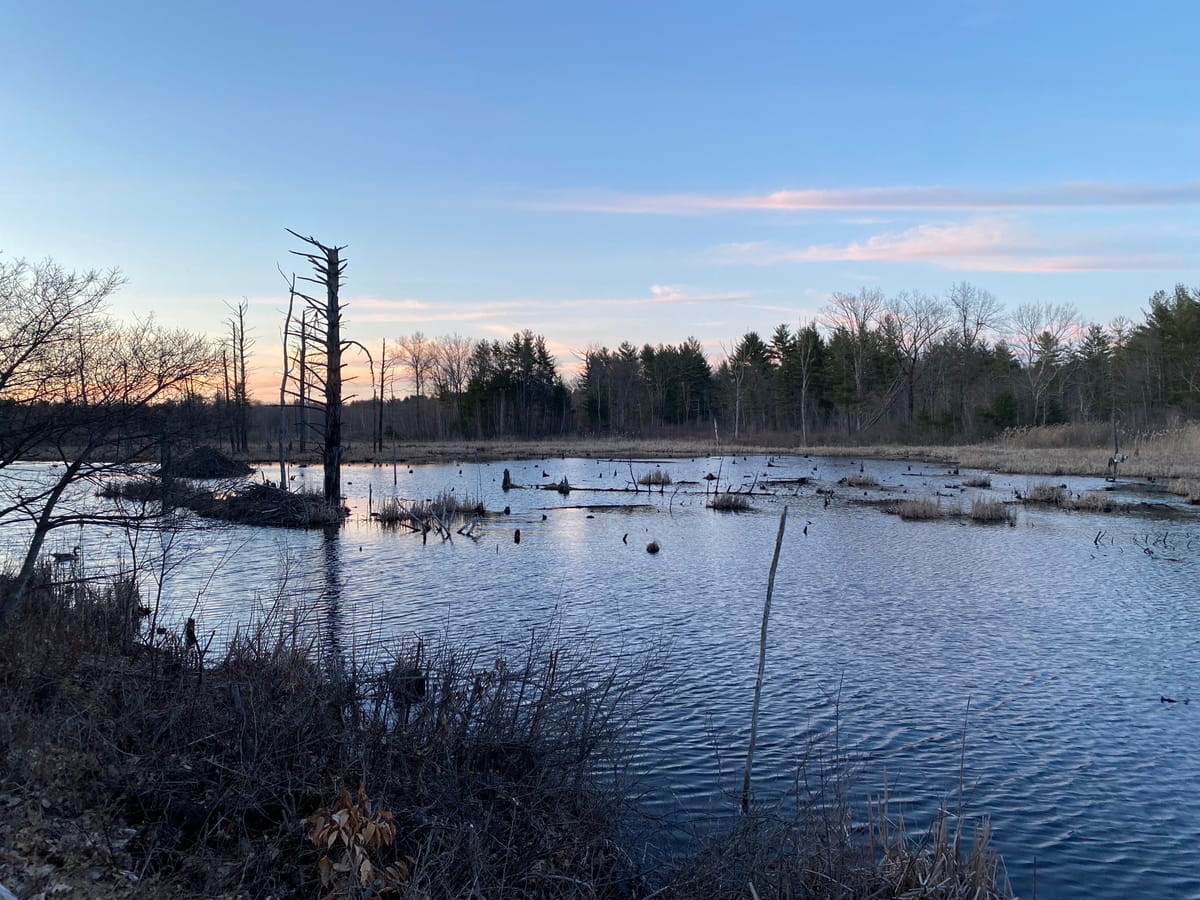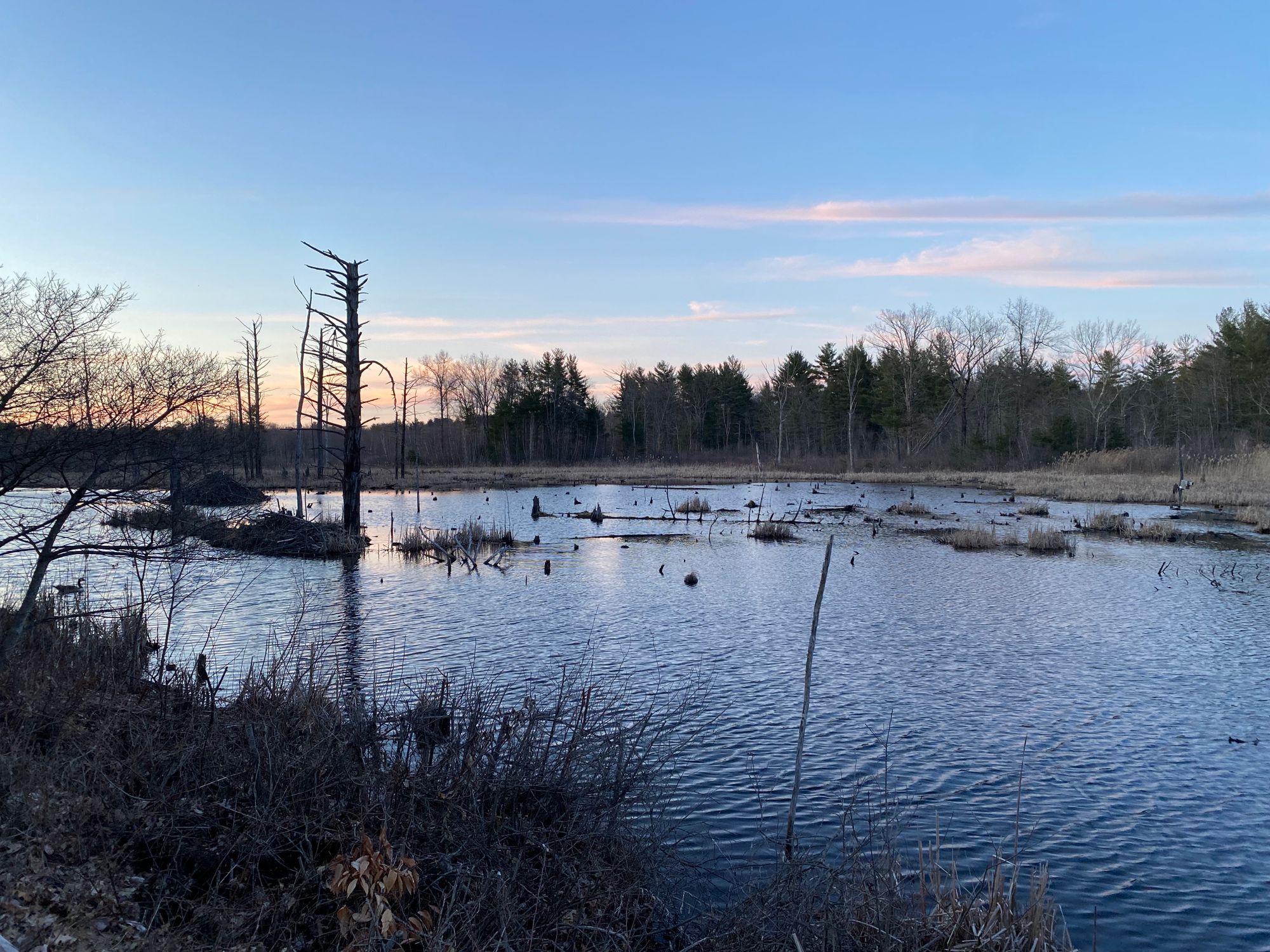Coping With Campus: Dam Good Builders
Managing Opinion Editor Dustin Copeland ’25 takes a jaunt off of campus, finding tranquility and engineering in the local beaver population.


An integral part of living healthily in the at-best semipermeable bubble of campus is to, once in a while, intentionally break it. Recontextualizing the space we live in is vital to continuing to live in that space — something that begins to feel prohibitively difficult once in a while without careful attention. Leaving campus is hard, and often I find myself realizing, as if waking out of a daze, that I haven’t broken its borders in weeks. If you are a student with a car on campus, you don’t need to read this article.
Luckily for the rest of us, our campus is in pretty much the perfect location, and as such, has several easily accessible changes of scenery. There is town, of course, and the veiny network of buses and bike lanes that brings closer the Five Colleges (however inconveniently), Hadley, and even comparatively metro Holyoke and Springfield. But crucially for this article, the Mass Central Rail Trail cuts right through the south end of campus proper. With a maintained paved surface running continuously from Northampton to some road off of Route 9, a few miles southeast of campus, the rail trail is a ridiculously easy-to-access conduit bringing hiking trails, tree cover, and nature preservation land close to campus. The ideal way to travel the rail trail is by bike, but walking is the most common and certainly the most contemplative. And, if you walk or bike far enough, you might happen across something truly awe-inspiring. Beavers, for example.

Beavers create their homes, called beaver lodges, in ponds deep enough to prevent ice from blocking lodge entrances. Mostly, those ponds are created by beaver dams, which flood an area around a river until the beavers are satisfied with the size and depth. Whether or not the beaver pond I found down the Rail Trail was a pond created by beaver damming is unknown, but the presence of beaver lodges is certain. Open-water beaver lodges like those in the beaver pond are freestanding structures built over a foundation of sticks. The domed roof is sealed with mud, and an air vent on top provides fresh air and light to the rooms below. Entrances to the lodge are underwater, but the living chamber is kept above the waterline. A dining area is often set aside near the water, and experienced beaver families can build lodges 20 feet in diameter and over six feet high. Moreover, in just two nights, families can build a lodge sturdy enough to survive all of winter.
Beavers produce their own living environments by taking advantage of an area’s natural resources. They create a new ecosystem by diverting rivers, changing stream flows, and flooding dry land. They engineer their living space while paying attention to their needs in a residential environment, and with experience and skill, create long-standing and complex homes to specifications that they decide. In other words, beavers make buildings. They’re architects!
It might seem that the story of the beaver is one familiar to human ears: while magnificent, their designs are a drain on their environments, destroying river life and cutting down an area’s tree cover. Beavers, in their selfish species-centered commitment to their own survival, put the existence of the very planet they live on as a secondary concern as they reshape the Earth as they see fit.
But beavers aren’t just like humans. Not only do they manage to create buildings and use their evolutionary abilities to change the environment as is necessary for their survival, but their doing so is invariably good for the places where they live. This is the opposite of what it should be! Urbanism and nature are diametrically opposed! Structural reconfiguration of one’s environment seems to be universally bad for non-human life when it is humans doing the configuring, but the same just isn’t true for beavers.
Beavers are a keystone species in their habitats, which means that the ecosystems they live in rely on the presence of beavers — their removal would dramatically change the nature of the ecosystem. As literal habitat creators, beavers’ roles as engineers and architects make them indispensable to the variety of life that lives alongside them. Beaver ponds increase the area of open water so much that beavers are able to build and sustain wetlands even during extreme drought. That same open water means that waterfowl thrive in environments with beavers, and beavers’ interaction with trees at the pondside is strongly associated with the richness and abundance of migratory bird species. Beavers’ destruction of riparian trees — those lying on the interfacing area between land and pond — doesn’t drive tree populations down, but rather increases the amount of trees and vegetation, as well as their diversity. Beavers have been used by the United States Civilian Conservation Corps to prevent soil erosion, and employed by various state governments, as well as Canadian provinces, to restore streams and wetlands across those countries. There’s a Wikipedia article entitled “Environmental impacts of beavers” wherein every single subheading is unambiguously positive. Study after study shows that beaver ponds serve as firefighters or that salmon population reduction is related to declines in beaver population or that most studies claiming that beaver dams act as barriers to fish were unsupported by data. And while it’s certain that beavers aren’t truly good 100 percent of the time, the volume of positive effects they have on their environments mean that, even when they are literally invasive, they are not wholly detrimental to local ecology.

That day on the Rail Trail was a welcome jaunt away from the Amherst bubble. Frog calls and distant birds combined with the steadily-rippling water which was silvery and gleaming in the waning sunlight. It was a wild experience, so deeply tranquil and so essentially satisfying. I saw beavers swimming silently before slipping under the surface. Gathering for dinner, maybe.
I thought (as my friend on the trail suggested) that beavers were as vicious as humans, that their buildings were a product of environmental exploitation not at all dissimilar from the stair-welled straight-lined dorm I would eventually return to. I thought about the difference between people and animals, and how creatures like beavers are perfect examples of how we humans are not uniquely endowed with the ability to change the planet on which we live. We are not the only creatures who build, not the only animals to design a space.
But my thinking was still incomplete. “Human” forms of interacting individually with spaces are not at all unique to us, and we don’t share them solely with beavers — octopuses, for example, decorate their dens. Our intelligence is also a useless measure: it makes no sense to call us better than other species based solely on the quality we happen to be best at! How convenient.
I think that humans aren’t the greatest species on the planet for a wide variety of reasons, but is it fair to say that we’re the best at building? Luckily, since we are not the only species to do architecture, we can compare our home-building to that other venerable constructor. Both of our homes are complex, unique to the builder, and provide for the spaces essential for comfortable living, protected from the world outside. One style of home-building, however, is so integrated with the ecosystem around it that its engineering and the health of the surrounding earth are essentially symbiotically related. The other, unfortunately, is so harmful to the planet that it threatens the well-being of all living things, even the home-users themselves. In other words: not only do beavers do architecture, they do it better than us.


Comments ()